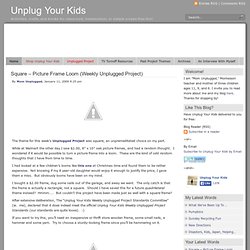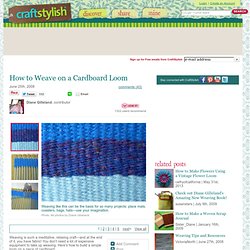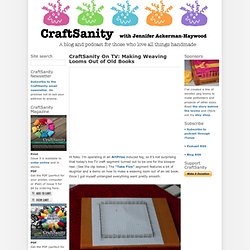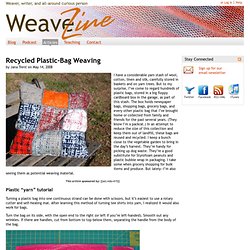

Weaving techniques sur Pinterest. Woven Seed Bead Ring- Tutorial. How to make Woven Seed Bead Rings I made these rings with my 10yo's 4-H group, it's a great activity for kids ages 7+.

The tweens and teens REALLY got into it! See my post here all about the project. You'll notice in the picture that the rings all vary a bit with their bead colors and design motifs... the kids very quickly figured out that they could change the bead colors and numbers to create their own styles. Watching this process develop was one of my favorite parts of the workshop! 1. 2. 3. 4. 5. 6. 8. 10. 12. 13. 14. 15. 16. Square – Picture Frame Loom (Weekly Unplugged Project) The theme for this week’s Unplugged Project was square, an unpremeditated choice on my part.

While at Walmart the other day I saw $2.00, 8″ x 10″ oak picture frames, and had a random thought. I wondered if it would be possible to turn a picture frame into a loom. These are the kind of odd random thoughts that I have from time to time. I had looked at a few children’s looms like this one at Christmas time and found them to be rather expensive. Not knowing if my 8 year-old daughter would enjoy it enough to justify the price, I gave them a miss. I bought a $2.00 frame, dug some nails out of the garage, and away we went. After extensive deliberation, The “Unplug Your Kids Weekly Unplugged Project Standards Committee” (ie. me), declared that it does indeed meet the official Unplug Your Kids Weekly Unplugged Project Standards (our standards are quite loose). :) If you want to try this, you’ll need an inexpensive or thrift store wooden frame, some small nails, a hammer and some yarn.
How to Weave on a Cardboard Loom. June 25th, 2008 Email 1322 users recommend Weaving like this can be the basis for so many projects: place mats, coasters, bags, hats—use your imagination.

All photos by Diane Gilleland Keep your edges a little loose, and they'll stay nice and straight. An ordinary salad fork makes a great tool for keeping your weaving snug. Photo: All photos by Diane Gilleland 1 | 2 | 3 | 4 | 5next> View all Weaving is such a meditative, relaxing craft—and at the end of it, you have fabric! I like to re-use cardboard shipping envelopes for my simple looms. Begin by deciding how wide you want your weaving to be. Next, measure and mark every 1/4 inch along the edge of your cardboard, working between the two width marks you made in the previous step. Draw a line 1/2 inch from the edge of the cardboard. Use a pair of strong scissors to cut a series of slits in the edge of the envelope, 1/4 inch apart. Repeat these steps on the opposite edge of the cardboard. View 1 member project gallery. Weaving on old books. Hi folks.

I’m operating in an ArtPrize induced fog, so it’s not surprising that today’s live TV craft segment turned out to be one for the blooper reel. (See the clip below.) The “Take Five” segment features a bit of laughter and a demo on how to make a weaving loom out of an old book. Once I got myself untangled everything went pretty smooth. I call this clever recycled book loom the “Jager” loom because I got this project idea from Margaret Jager, a member of the Woodland Weavers and Spinners guild and co-chair of the impressive 16th Biennial Fiber Arts Exhibition featuring work by many local fiber artists who are members of The Michigan League of Handweavers. (My Sunday column will feature more details about the show, so check here this weekend for more details. WeaveZine: Learn How to Weave: Free Weaving Projects, Podcasts, and More! I have a considerable yarn stash of wool, cotton, linen and silk, carefully stored in baskets and on yarn trees.

But to my surprise, I’ve come to regard hundreds of plastic bags, stored in a big floppy cardboard box in the garage, as part of this stash. The box holds newspaper bags, shopping bags, grocery bags, and every other plastic bag that I’ve brought home or collected from family and friends for the past several years.
(They know I’m a packrat.) In an attempt to reduce the size of this collection and keep them out of landfill, these bags are reused and recycled. I keep a bunch close to the vegetable garden to bring in the day’s harvest. This article sponsored by: [[ad|nids=415]] Plastic “yarn” tutorial Turning a plastic bag into one continuous strand can be done with scissors, but it’s easiest to use a rotary cutter and self-healing mat. Turn the bag on its side, with the open end to the right (or left if you’re left-handed).
Ta Da!